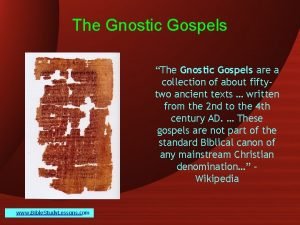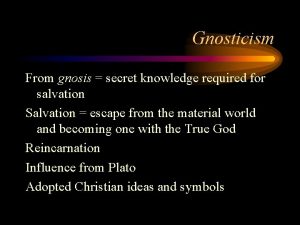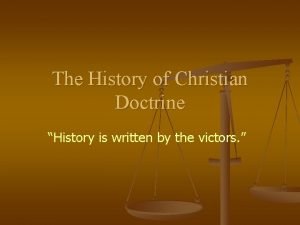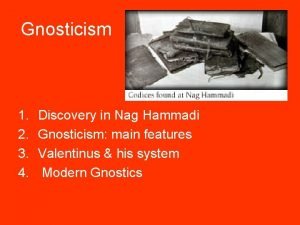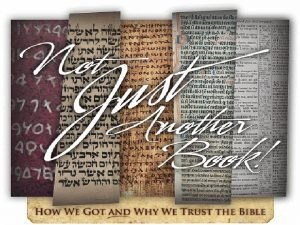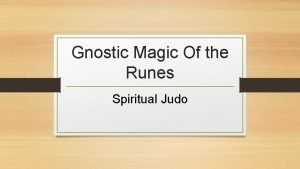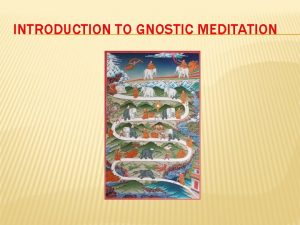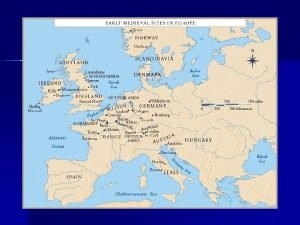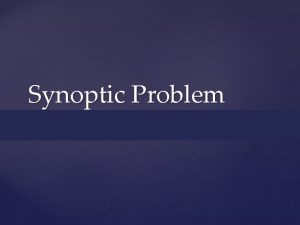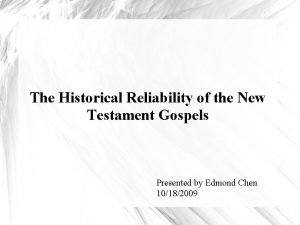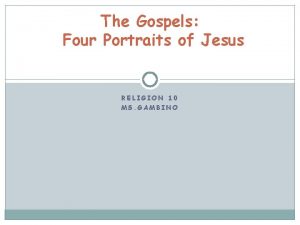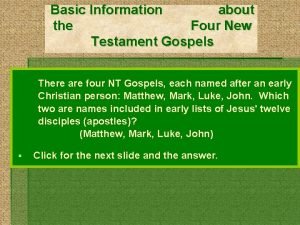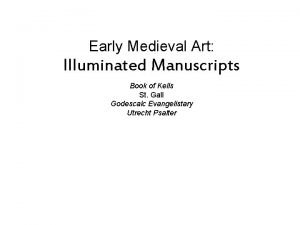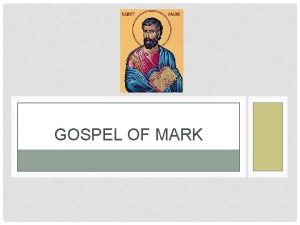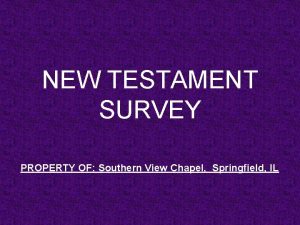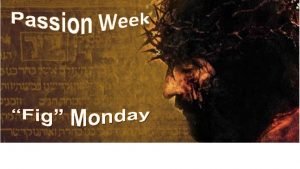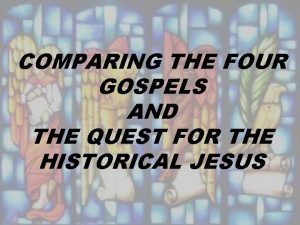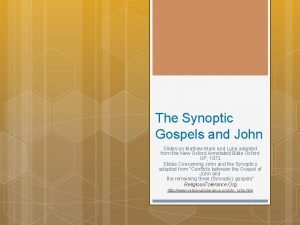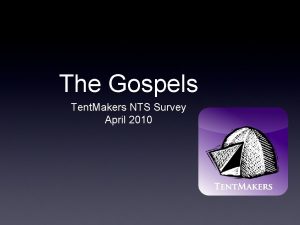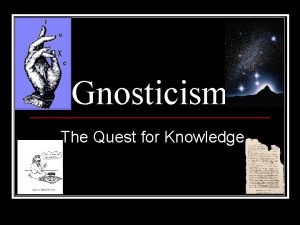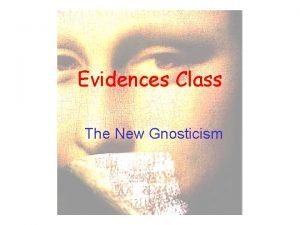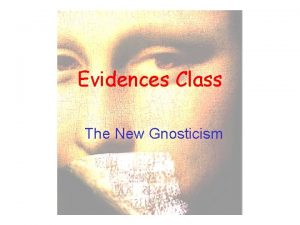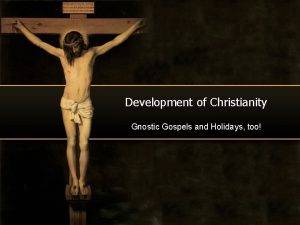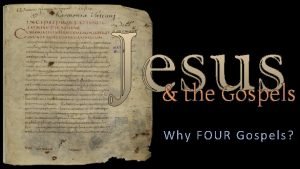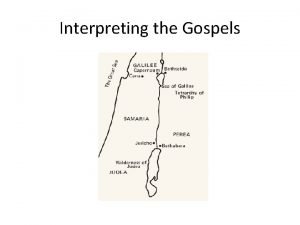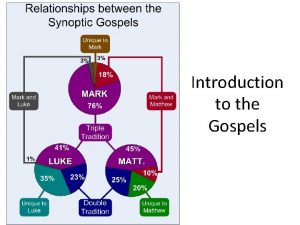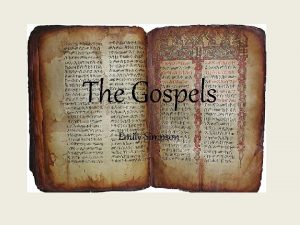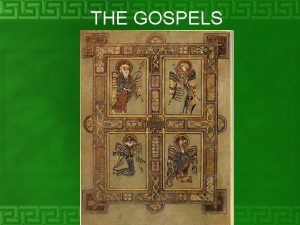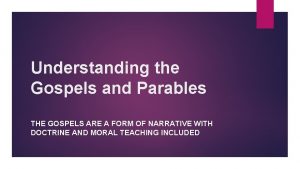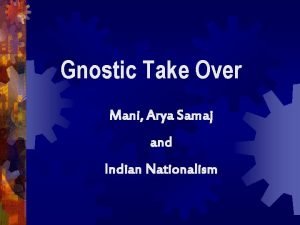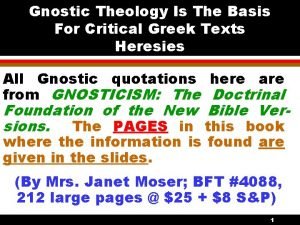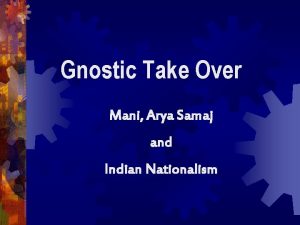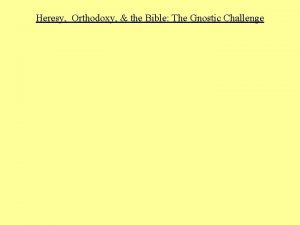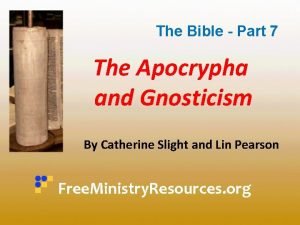What is Gnosticism What are the Gnostic Gospels



























































- Slides: 59

What is Gnosticism? What are the Gnostic Gospels? 1

In The Da Vinci Code… “Fortunately for historians… some of the gospels that Constantine attempted to eradicate managed to survive. The Dead Sea Scrolls were found in the 1950 s hidden in a cave in Qumran in the Judean desert. And of course, the Coptic Scrolls in 1945 at Nag Hammadi. In addition to telling the true Grail story, these documents speak of Christ’s ministry in very human terms… The scrolls highlight glaring historical discrepancies and fabrications, clearly confirming that the modern Bible was complied and edited by men who possessed a political agenda – to promote the divinity of the man Jesus Christ and use His influence to solidify their own power base. ” -- scholar Leigh Teabing in The Da Vinci Code, p. 234.

Outline n Background Early Church n The world into which the Early Church spread n n Gnosticism Tenets n Most important schools n Reasons for its appeal n Problems that led to its rejection n

Outline n Sources of Our Knowledge About Gnosticism n The Nag Hammadi Library

Background The Early Church

Background Timelines n New Testament Period Apostolic Period (30 to 65 AD) n Post-apostolic Period (65 to 95 AD) n n The “Patristic” Age (95 to about 600 AD) n Pre-Nicene Period (95 to 325 AD) n includes Period of the Apostolic Fathers, (95 -160) n 325 AD: The Council of Nicene n “Golden Age” of the Nicene Fathers (325 to 451 AD) n 451 AD: The Council of Chalcedon n Post Chalcedon Period (451 to 600 AD)

Background Timelines Age of “Medieval” Theology (formalism, scholasticism, Byzantine systemization), 6001300 AD n Age of Reformation of the Church and Dogma, 1300 -1700 AD n Modern Age (1700 AD – present) n

Background Two Great Dividing Lines n Two great “dividing lines” n 1. East versus West n Eastern Church (Greek speaking churches in what would become Eastern Roman Empire / Byzantine Empire): tended to be intellectually adventurous and inclined to speculation n Western Church (Rome and other Latin speaking Churches in Gaul, Spain, North Africa): more cautious, even pedestrian n 2. Constantine I (306 -337) n Before: Church was a struggling, persecuted body n After: Church enjoyed “often embarrassing favor of the State”

Two Great Dividing Lines East versus West n Western Apostolic Fathers Irenaeus (c. 140 -160 to 200), Bishop of Lyons in Gaul n Tertullian (c 155 to 220) of Carthage n Hostile to philosophy n Function of theology to expound the doctrines found in the Holy Scriptures n Applauded simple believers content with rules of faith n

Two Great Dividing Lines East versus West n Eastern Apostolic Fathers Clement of Alexandria (150 to 215 AD) n Origen (185 to 254 AD), succeeded Clement as head of the catechetical school of Alexandria n Embraced philosophy n Described two kinds of Christianity: n n 1. Simple believers (disparaged) n 2. “Spiritual” believers, “Gnostics” or the “Perfect, ” who explored the deeper meaning of Scripture and the mysteries of God, culminating in mystical contemplation or ecstasy

Two Great Dividing Lines Constantine I n Major Periods of Persecution: 64 to 66: Rome, by Nero (local) n 85 to 95: Asia Minor, by Domitian (local) n 110 to 160: Rome, Asia Minor and Palestine (intermittent and mostly local) n 250 to 313: empirewide, by several emperors, particularly Decius (250 AD), Diocletian (284305), and Galerius (304 -311) n From Mc. Donald and Porter, p. 263.

Background The Ancient World into Which Christianity Spread

Background World Into Which Christianity Spread Christian theology did not take shape in a vacuum n It grew amid a world crowded with diverse religious and philosophical notions: n Oriental “Mystery” Religions n Greco-Roman Philosophy (Platonism, Stoicism) n Palestinian Judaism, and particularly the Hellenized Judaism of Alexandria n n Syncretism abounded

Background World Into Which Christianity Spread n Gnosticism n n One of the most potent forces operating in the early Church’s environment in the second and third centuries Not a separate “church” or “religion”, but an amorphous school of sects, schools of thought “A product of syncretism, it drew upon Jewish, pagan, Oriental sources” (Kelly p. 23) “Gnosticism can be regarded as a first (and unsuccessful) attempt to combine Christianity and Platonism in the second and third centuries A. D. ” (Cary, p. 45)

Background World Into Which Christianity Spread n n World into Christianity spread was hungry for spirituality Monuments attest to a desperate longing in all classes for assurance against death and fate, redemption from evil, union with the divine Gods of Greek and Roman Mythology no longer inspired Cult of the Emperor provided only a mode of corporate loyalty, perhaps a sense the Empire was favored by Providence

Background Oriental Mystery Religions n n n Oriental Mystery Religions Popular Among the Masses Had spread rapidly across the Roman Republic / Empire in the century before Christ Most popular divinities: n n Isis, Egyptian mother goddess of fertility Serapis, Egyptian deity associated with the dead and with healing Cybele (Anatolian mother-goddess) and Attis (her youthful lover, the vegetation god) Persian God Mithras, god of light, ally of the Sun n Especially popular among soldiers

Background Oriental Mystery Religions Consisted of close-knit groups, fellowships n Shared sacred meals n Newcomers initiated by secret ceremonies (“mysteries”) n Preparatory stages included abstinences, mortifications, purifications n Culminated in secret cultic actions to secure initiates’ union with the divine n n For example: in rite of Cybele and Attis, initiate “baptized” by the blood of a bull or ram slaughtered above him

Background Oriental Mystery Religions n The syncretism of the times led to a growing monotheistic interpretation of the many various pagan gods as simply manifestations or personifications of one unique, supreme Power or God

Background Graco-Roman Philosophy n Among the educated, philosophy served as their “religion. ” Most influential: Platonism n Stoicism n n Syncretism prominent; in practice many were “Platonic Stoicists” or “Stoic Platonists”

Background Graco-Roman Philosophy: Platonism n Human beings 1. A Material Body, mortal n 2. A Soul, immortal, part of the true, transcendental, divine world n n “Rational” element – can apprehend truth n “Spirited” element – seat of the noble emotions n “Appetitive” element – sea of carnal desires

Background Graco-Roman Philosophy: Platonism n n Natural world in which we live is but a shadow of true reality True reality is a “divine” transcendental world the “Forms” or Universals existed n n n Examples: Beauty, Justice, Goodness, “Tree-ness, ” “Mountain-ness, ” “Horse-ness” The “Forms” illuminate the matter of this world to produce the “shadowy” examples of beauty, justice, goodness, trees, mountains, horses that we see in this world Matter itself, un-illuminated by the Forms, is darkness and non-being; hence evil

Background Graco-Roman Philosophy: Platonism n Problem of our life on earth: Our immortal souls descended from the divine realm and have become trapped in our bodies n We can vaguely perceive true reality (the Forms) in matter (they are “intelligible” to us) because our souls belong to the same transcendental, divine world as do the Forms and long to return to it n

Background Graco-Roman Philosophy: Platonism n Hierarchy of Being* n 1. The “One” (God) n Incomprehensible, beyond all Being, all Mind, all Forms n The source from which Being derives, the Goal that all Being strives to return to n All Being emanates from the “One” like light from the Sun n recall in the Creed, “light from light” * As developed in Neo-Platonism

Background Graco-Roman Philosophy: Platonism n Hierarchy of Being n 2. The Divine “Mind” n An emanation of the “One” n Eternally contemplates the “Forms” which are contained within itself n The Platonic Forms are thus Ideas in the Mind of God n Incapable of change

Background Graco-Roman Philosophy: Platonism n Hierarchy of Being n 3. Soul n An emanation of the Divine Mind, but capable of change and entering into matter n All our individual souls are but particles of the one Soul n The Fall: Our individual souls became separated from the Soul when out of curiosity and arrogance they descended into bodies

Background Graco-Roman Philosophy: Platonism n Hierarchy of Being n 4. The Visible World n The previous levels of Being -- One, Mind, Soul -- were divine and hence immortal n The bottom level of Being, the visible world, is a mortal world of bodies, change, growth, decay n Inert matter is darkness and non-being, and hence evil

Background Graco-Roman Philosophy: Platonism n Notes: n n All that exists is an “overflow” of the “One” The other levels of reality exist not out of the choice of the “One, ” but are the inevitable result of the abundance of the emanations of the “One” In each level there is an ardent longing (“Heavenly Eros”) for union with what is higher Plato’s Symposium: stages for the ascent of the individual soul: n n n 1. Purification, freeing oneself from bodily lusts and the beguilements of the senses 2. Look towards the Divine Mind by occupying oneself with philosophy and science 3. Mystical union with the One, mediated by ecstasy

Gnosticism

Gnosticism Introduction n Refers to an amorphous group of sects Represent the most important heresies faced by the early Church Name “gnosticism” a creation of modern scholarship n n Early Christian writers generally referred to a “Gnostic” group by the name of the founder “Gnostic” was a perfectly good title in the early Church n n One who had access to the knowledge revealed in Christ The Gnostic: book by Evagrius Ponticus about the ideal monk

Gnosticism Tenets of Gnosticism In the beginning, there was One God, perfect, incomprehensible, unknowable, totally transcendent n From the One God other divine entities called aeons emanated. From these aeons emanated more divine entities, other aeons n An entire realm of divine aeons thus developed, call the Fullness or Pleroma n

Gnosticism Tenets of Gnosticism n The world of matter was not created by the One God, but resulted from some kind of disruption in the divine Pleroma, a catastrophe in the cosmos. And in some human beings in this world of matter there resides a divine spark of the Pleroma, which needs to be liberated to return to the divine world of the Pleroma

Gnosticism Tenets of Gnosticism n One version of how the world of matter and human beings were created (Secret Book of John): The lowest aeon named Sophia (Wisdom) generated a divine being apart from her male consort, resulting in a malformed and imperfect offspring n Sophia hid her offspring outside the divine realm of the Pleroma to prevent his discovery and left him n

Gnosticism Tenets of Gnosticism Sophia named her offspring Yaldabaoth (“Yahweh, Lord of the Sabbath”); he was the God of the Old Testament n Yaldabaoth uses his divine power to create: n n lesser divine beings, the evil forces of the world, n The evil material world (he is the Demiurge, Greek for “maker” or “craftsman”) n Yaldabaoth is ignorant of the Pleroma and foolishly declares “I am God and there is no other God beside me” (Isa. 45: 5 -6)

Gnosticism Tenets of Gnosticism Yaldabaoth is then granted a vision of the One God and decides to make human beings in the image of the One God n Adam as created by Yaldabaoth is inanimate, but the One God allows the divine spark of Sophia to enter into human beings, making them animate and greater than Yaldabaoth and all his evil cosmic powers n When Yaldabaoth and the evil cosmic forces realize this, they cast human beings into the evil realm of matter n

Gnosticism Tenets of Gnosticism n Problem of our life on earth: n The only way that the divine spark that resides in some human beings can return to the divine Pleroma where it belongs is to learn the secret or “mystery” of what it is and where it belongs n Knowledge of this secret breaks the tethers binding the divine spark to the world of matter and allows the divine spark to successfully ascend to the Pleroma after death n But how can we learn this secret? The world of matter is evil, and the only knowledge that can be acquired in the world is knowledge of materials

Gnosticism Tenets of Gnosticism n Answer for Christian Gnostics: Christ came to reveal this secret knowledge. This knowledge of who one really is (a divine spark trapped in an evil material body) is the key to salvation In other words, salvation is achieved by truly knowing thyself. Salvation is found within n Christ speaking in the Gnostic Gospel of Philip “The one who possesses the knowledge (gnosis) of the truth is free. ” (G. Phil. 93) n

Gnosticism Tenets of Gnosticism n How could Christ enter the evil world of matter? Most common version: Christ was an aeon who descended and entered the man Jesus at Jesus’ Baptism n Christ the aeon left Jesus when he was before Piliate, so only the man Jesus suffered on the cross n n Hence Jesus’ words in the Gnostic Gospel of Philip “’My God, my god, why O Lord have you forsaken me? ’ He spoke these words on the cross, for he had withdrawn from that place. ” (G. Phil. 64)

Gnosticism Tenets of Gnosticism n Gnostic tract Second Treatise of the Great Seth 56: 6 -19 “It was another … who drank the gall and vinegar; it was not I. They struck me with the reed; it was another, Simon, who bore the cross on his shoulder. It was another upon whom they placed the crown of thorns. But I was rejoicing in the height… over their error… And I was laughing at their ignorance. ” n Literal “resurrection” of Christ rejected n Christ, the divine aeon, had already left the man Jesus

Gnosticism Tenets of Gnosticism n Some Christian Gnostics said there were 3 kinds of human beings: n 1. The Carnal or Material. Creations of the Demiurge without any divine spark n have no hope of salvation; when they die they are annihilated 2. The Psychic. Can be saved with difficulty through the secret knowledge and by imitating Jesus n 3. The Pneumatic. Needed only the secret knowledge n

Gnosticism Tenets of Gnosticism n Gnostics tended to be ascetics. Logic: Since the body was evil, it should be punished n Attachment to the body is problem of existence, and pleasure is a means of becoming attached to the body. Therefore, it is best to deny the body pleasure n

Gnosticism Most Important Gnostic Schools n Valentinus Egyptian by birth n Taught at Alexandria, later in Rome (136 to 160) n May have authored the Nag Hammadi document Gospel of Truth n His disciple Ptolemy (about 180) wrote Nag Hammadi document Letter to Flora n

Gnosticism Most Important Gnostic Schools n Valentinus Had a very elaborate system of orders of divine beings n Accused by Irenaeus in Against Heresies 1: 11. 1 of teaching God was a dyad: n n 1. the Ineffable, the Depth, the Primal Father n 2. Grace, Silence, the Womb, and “Mother of the All” n The womb of the feminine part of God received the seed of the Primal Father / Ineffable Source to bring forth the many levels of emanations of divine beings

Gnosticism Most Important Gnostic Schools n Basilides Born in Syria n Lectured at Alexandria about 120 to 140 AD n Major work Exegetica, a biblical commentary to 24 books n Claimed to follow secret traditions from St. Peter and St Matthias n

Gnosticism Most Important Gnostic Schools n Others Menander of Samaria, practiced Magic Arts n Satornilus (or Saturninus) of Antioch. Emphasized asceticism n Isidore, son and disciple of Basilides. Said spiritually perfect free to be immoral n Carpocrates: carried to extreme the idea that for the saved, right conduct unnecessary n

Gnosticism The Appeal of Gnosticism Explained our sense of alienation in this world (our true selves, the divine spark within us, belongs in the divine) n Explained the presence of evil and suffering in the world (the material world was evil, not made by God, but by an evil Demiurge) n Offered a means of the reconciliation of the human spirit with the ineffable sublimity of God n

Gnosticism The Problem with Gnosticism n Ultimately rejected by the Church because: Its radical dualism. The Creator, creation, matter, and the body were evil. Our souls alone good, belonging in the divine world of the Pleroma n Its rejection of the Incarnation, the significance of God truly taking on human and material form, and living and suffering as a human being. The Christ aeon divinity used the human being Jesus merely as a temporary dwelling and hiding place n

Sources for Our Knowledge About Gnosticism

Sources n The Apostolic Fathers Irenaeus, Bishop of Lyons, Gaul (140 -160 to 200 AD) five volume work Refutation and Overthrow of Gnosis, Falsely So-Called = Against Heresies n Tertullian of Carthage (155 to 222 AD). Several treatises against heretics n Hippolytus of Rome (170 to 235 AD), Refutation of All Heresies n n Discovered in the 19 th century

Sources n Original Gnostic documents n A few surfaced in 18 th and 19 th century: n 1769 and 1773: Coptic manuscripts of Gnostic texts first appeared (purchased by tourists) n 1890’s: a few fragments of a Greek Gospel of Thomas discovered n 1896: Gospel of Mary Magdalene, Apocryphon (Secret Book) of John, and two other texts for sale by German Egyptologist in Cairo n December 1945: discovery of the Nag Hammadi Library

Sources Nag Hammadi Library December 1945: Muhammad Ali al-Samman and his brothers were digging for sabakh, a soft soil for fertilizing crops, at the Jabal al. Tarif, a mountain honeycombed with more than 150 caves, near the town of Nag Hammadi in Upper Egypt n Hit a one meter high red earthenware jar n Smashed the jar, and found it contained 13 papyrus books bound in leather and some loose papyrus leaves n

Sources Nag Hammadi Library n n Muhammad Ali had discovered a library of Coptic translations of 52 original Greek texts from the early years of Christianity, buried for 1600 years Primarily Gnostic texts, including: n n n n Gospel of Thomas Gospel of Philip Gospel of Truth Gospel to the Egyptians Secret Book of James Apocalypse of Paul Letter of Peter to Philip The Apocalypse of Peter

Sources Nag Hammadi Library Muhammad Ali brought the books home, where his mother burned much of the loose papyrus leaves to kindle their oven fire n A few weeks later, Muhammad Ali and his brother avenged the murder of their father in a blood feud by gruesomely murdering Ahmed Isma’il n

Sources Nag Hammadi Library n n n Not wanting the police investigating the murder to find the books, Muhammad Ali gave them to a priest al-Qummus Basiliyus Abd al-Masih to keep for him Raghib a local history teacher, saw one of the books, and suspected their value Books ended up on the black market, came to the attention of the Egyptian government, who brought one and then confiscated 10 and a half of the leatherbound books for the Coptic Museum in Cairo n Thirteenth volume smuggled to America and sold

Sources Nag Hammadi Library n Coptic Museum kept strict control over publication rights 1972 to 1977: nine photographic volumes of all 13 papyrus books published, putting the library into the public domain n Some material circulated among scholars before this n

Sources Nag Hammadi Library Leather of the books and notations within them date the books to sometime after 348 AD n Lid of the jar dates to 4 th or 5 th century AD n Conjecture is that books came from the library of a nearby monastery led by Pachomius (Basilica of St. Pachomius near the area) n 367 AD: Pachomius’ successor Theodore purged heretical books from his monastery n Monks objecting to this may have buried the codices. Site found also to be an ancient Byzantine burial site n

Sources Nag Hammadi Library n Gospel of Thomas Probably the most famous of the texts n Most scholars agree it is a “Gnostic” Gospel n Collection of 114 sayings of Jesus; no reference to the Passion or Resurrection n felt by Nag Hammadi scholars to be compiled about 140 AD n n Minority of scholars suggest a date in the first century

Sources Nag Hammadi Library n Other texts also believed to be written sometime in the second century AD, since: Irenaeus, Bishop of Lyons, complained in 180 AD that the heretics “boast that they possess more gospels than there really are. ” n Christian Gnostics first appeared sometime in the second century n

References 1 n n Breaking the Da Vinci Code, by Darrell L. Bock, Nelson Books, Nashville, 2004, ISBN 0 -7852 -6046 -3 Early Christian Doctrines. Revised Edition. J. N. D. Kelly, Harper. San. Francisco, New York, 1978 (revised edition). ISBN 0 -06 -064334 -X Lost Christianities. The Battle for Scripture and the Faiths We Never Knew. Bart D. Ehrman. Oxford University Press, 2003. ISBN 0 -19 -514183 -0 The Da Vinci Hoax: Exposing the Errors in the Da Vinci Code, by Carl E. Olson and Sandra Miesel, Ignatius Press, San Francisco, 2004, ISBN 1 -58617034 -1

References 2 n n The Emergence of the Catholic Tradition (100600). Volume 1 of The Christian Tradition. A History of the Development of Doctrine. Jaroslav Pelikan, University of Chicago Press, Chicago and London, 1971, ISBN 0 -226 -65371 -4 The Gnostic Gospels. Elaine Pagels, Vintage, 1989. ISBN: 0679724532 The Gospel Code. Novel Claims About Jesus, Mary Magdalene, and Da Vinci, by Ben Witherington III, Inter. Varsity Press, Downers Grove, Illinois, 2004, ISBN 0 -8308 -3267 -X The Penguin History of the Church 1. The Early Church. Revised Edition. Henry Chadwick, Penguin Books, London, 1993 (revised edition). ISBN 0 -14023199 -4
 David e. pratte wikipedia
David e. pratte wikipedia Mikael ferm
Mikael ferm Gnostic secret knowledge
Gnostic secret knowledge Gnosticism beliefs
Gnosticism beliefs What is gnosticism
What is gnosticism Aeon (gnosticism)
Aeon (gnosticism) Original nicene creed
Original nicene creed Gnosticism got questions
Gnosticism got questions Jesus royal bloodline
Jesus royal bloodline Runa hagal gnosis
Runa hagal gnosis Gnostic meditation
Gnostic meditation Synoptic gospels
Synoptic gospels St matthew ebbo gospels
St matthew ebbo gospels Business confidence definition
Business confidence definition Reliability of new testament
Reliability of new testament List the synoptic gospels
List the synoptic gospels 4 portraits of jesus in the gospels
4 portraits of jesus in the gospels Four new testament gospels
Four new testament gospels Chi rho iota page from the book of kells
Chi rho iota page from the book of kells Synoptic gospels
Synoptic gospels Bema judgement meaning
Bema judgement meaning Is the triumphal entry in all four gospels
Is the triumphal entry in all four gospels Comparing the four gospels
Comparing the four gospels The date
The date Gospels
Gospels The virgins memo genius
The virgins memo genius Lời thề hippocrates
Lời thề hippocrates Dạng đột biến một nhiễm là
Dạng đột biến một nhiễm là Vẽ hình chiếu đứng bằng cạnh của vật thể
Vẽ hình chiếu đứng bằng cạnh của vật thể Phản ứng thế ankan
Phản ứng thế ankan Môn thể thao bắt đầu bằng chữ đua
Môn thể thao bắt đầu bằng chữ đua Sự nuôi và dạy con của hươu
Sự nuôi và dạy con của hươu điện thế nghỉ
điện thế nghỉ Một số thể thơ truyền thống
Một số thể thơ truyền thống Biện pháp chống mỏi cơ
Biện pháp chống mỏi cơ Trời xanh đây là của chúng ta thể thơ
Trời xanh đây là của chúng ta thể thơ Gấu đi như thế nào
Gấu đi như thế nào Ng-html
Ng-html Thiếu nhi thế giới liên hoan
Thiếu nhi thế giới liên hoan Số.nguyên tố
Số.nguyên tố Fecboak
Fecboak Các châu lục và đại dương trên thế giới
Các châu lục và đại dương trên thế giới Thế nào là hệ số cao nhất
Thế nào là hệ số cao nhất Sơ đồ cơ thể người
Sơ đồ cơ thể người Tư thế ngồi viết
Tư thế ngồi viết đặc điểm cơ thể của người tối cổ
đặc điểm cơ thể của người tối cổ Mật thư anh em như thể tay chân
Mật thư anh em như thể tay chân Chụp phim tư thế worms-breton
Chụp phim tư thế worms-breton Bổ thể
Bổ thể Tư thế ngồi viết
Tư thế ngồi viết ưu thế lai là gì
ưu thế lai là gì Thẻ vin
Thẻ vin Cái miệng nó xinh thế chỉ nói điều hay thôi
Cái miệng nó xinh thế chỉ nói điều hay thôi Thơ thất ngôn tứ tuyệt đường luật
Thơ thất ngôn tứ tuyệt đường luật Các châu lục và đại dương trên thế giới
Các châu lục và đại dương trên thế giới Từ ngữ thể hiện lòng nhân hậu
Từ ngữ thể hiện lòng nhân hậu Diễn thế sinh thái là
Diễn thế sinh thái là V cc
V cc 101012 bằng
101012 bằng Chúa yêu trần thế
Chúa yêu trần thế
